The
Selling @ The Photographer's Gallery

Sex,
Politics, Religion + Fish - an art exhibition by
Amir
Muhammad
Jerome Kugan
Hariati Azizan
Danny Lim
Pang Khee Teik
| The
modern-day experience is a perpetual act of selling; a sales pitch for
goods, ideas and ourselves. The five debutant visual artists of The Selling
make their pitch for the transactions of living - sex, politics, religion
...and fish.
Film
reviewer and filmmaker Amir Muhammad explores the
commercialisation of the holy month of Ramadhan with images of food
stalls made to look like expensive abstract-expressionist
masterpieces, targeted at rich middle class Malays, of course.
Singer-songwriter
Jerome Kugan manipulated pornographic images them to
form hypnotic kaleidoscopic patterns with Old Testament names.
The Star writer
Hariati Azizan questions how Muslim women sells themselves
as pious beings by montaging images of tudungs over images of an exposed
body part.
The Edge writer
Danny Lim, a sometime photographer on indie film sets,
recontextualises the sales pitch of politicians, and re-sells Anwar
Ibrahim, Hishamuddin Hussein, Khairy Jamaluddin and Lim Kit Siang selling
themselves.
Kakiseni editor
Pang Khee Teik presents crowd-pleasing photographs
of Hong Kong night markets selling crowd-pleasing thongs, toys and goldfish
discoloured for good luck. |
Venue:
The Photographer's Gallery
183, Jalan Ampang,
Kuala Lumpur.
Dates:
June 10-30, 2005
For
more information, please visit our blog at http://theselling.blogspot.com |
Pictures for media
use (click
on thumbnails for large size jpegs):
1. Amir Muhammad [kancah2001@yahoo.com]
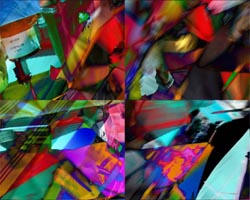
The Umbrellas of Ramadhan
1 (1.2MB)
|
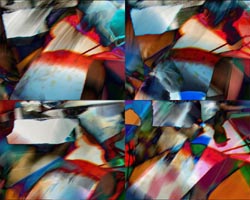
The Umbrellas of Ramadhan
2 (1.4MB) |
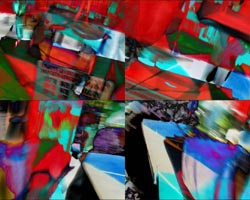
The Umbrellas of Ramadhan
3 (1.1MB) |
2. Jerome Kugan
[jeromekugan@hotmail.com]
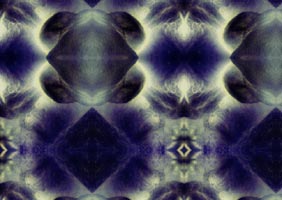
Job [566KB] |
3. Hariati Azizan
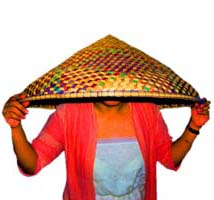
(620KB) |

(301KB) |
4. Danny Lim
[danlim@gmail.com]
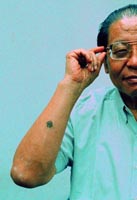
Kit Siang (1.6MB) |
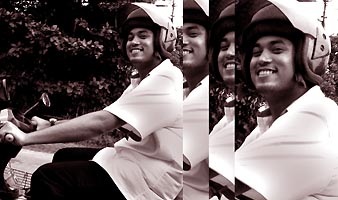
KJ (1.3MB) |

Hisham (2.1MB) |
5. Pang Khee Teik
[worldwithoutpangs@yahoo.com]

Happy Together (745KB) |
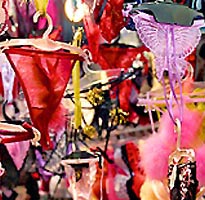
In The Mood For Love
(968KB) |
Artists' bio and
statement
1. Amir Muhammad (statement only):
These images were taken from a digital video camera at
a pasar Ramadhan last year. They were then
manipulated by superimposition with each other and
colour distortion.
Conspicuous consumption in the Malay-Muslim community
reaches a peak during these last hours of each fasting
day. Although Ramadhan is supposed to instill
restraint and moderation, it’s common to buy too much
food. Rather than moan about this, “The Umbrellas of
Ramadhan” chooses a celebration of sorts by turning
the spectacle into a series of vibrant colours and
dancing lights. The way the fasting month is
celebrated in this region helps make us unique. These
pasar Ramadhan are popular not only among Muslims (and
Muslims who fast, at that). It is a cheerful
life-affirming spectacle because Malaysians can always
be counted on to come together when food and bargains
are involved.
The resulting images deliberately invoke the abstract
type of art chosen by many Malaysian Muslim painters
in the last few decades in swerving away from
figurative (considered un-Islamic) art. But if you
look closely enough you can see figures buying and
selling food, as well as price-lists, words like ‘air
bandung’ and brand-names. These subtle but
recognizable reductive signifiers then make the works
not that abstract after all.
The numbers are part of the strategy. There are 30
panels in each of the three works, representing the 30
days of the fasting month. (Although in the third
part, one panel is left seemingly blank because the
fasting month sometimes lasts only 29 days, depending
on whether the new moon is sighted or not), Even the
price of RM1,000 is deliberately chosen because the
holiest night in Ramadhan (nobody knows when this
takes place) is described as one which is worth "a
thousand months". It is believed that this night takes
place during 'the last third' of the month – this
common way of breaking up the month into 3 is
responsible for the fact that there are 3 parts.
2. Jerome Kugan:
Twenty-nine-year-old Jerome Kugan, originally from Sabah, graduated from
the University of Canberra, Australia with a BA in Commnications (Professional
Writing Specialisation). He is currently working as a freelance writer, based
in Kuala Lumpur. He has written for New Straits Times, Options/The Edge, KLue,
www.kakiseni.com, and other publications. His other interests include poetry,
music and art. He was involved in Reka Art Space’s second annual Open
Show in 2004, in which he submitted four pencil drawings for exhibition. This
is the first time Kugan has produced work expressly for an art exhibition.
Statement:
“Symmetry” consists of seven digitally manipulated images of
gay male pornography originally downloaded from the Internet. It is decontextualised,
mystified and recontextualised, in indirect homage to the ‘found art’
and ‘collage’ work of early 20th century Dada and Surrealist artists
such as Marcel Duchamp and Max Ernst, by turning a “real” object
with recognisable features into a “surreal” subject (in which
the metaphor becomes the “real”).
The aim of this “surrealification” process is to interpret/explore
some of the psychosexual workings of pornography, a medium that bridges human
fantasy and reality. Using Windows Paint and Adobe Photoshop, parts of the
original pornographic images are inverted/multiplied/cropped/relocated/filtered/remixed
to create other parts of a new whole (or perhaps new defragmentations?), producing
repetitively symmetrical images that are locked into rectangular grids.
This process of reordering of the visual components of the images into such
tyrannical grids is meant to represent the interlocking gaze of the artist,
spectator and the image in the production, definition and appreciation of
pornography. Viewers are encouraged to look for the erotic, if and where it’s
still intact. However, viewers can also look at the images as metaphors for
other things, in which the subject of pornography is no longer relevant, and
their “real” meaning(s) open to interpretation.
The images are given the names of heroic/tragic figures from the Old Testament.
Perhaps a naïve attempt at restoring a false sense of innocence to figures
that were once denuded? Or to situate the currently obscene within the nostalgically
divine? Or a pathological desire in the artist for the pornographic subject
to remain pure but still reveal the body? Who knows?
3. Hariati Azizan:
Hari Azizan works as a journalist with a local daily, specializing in education
issues.
She describes her involvement in the arts as sporadic, the most notable of
which is her participation in Five Arts Center’s Young Director’s
Workshop IV, in which she attempted to stage the controversial play Vagina
Monologues. She is also a trained teacher and has worked with children in
theatre at TheActors Studio Academy, and community arts programmes with Five
Arts Centre. Currently is on a quest for the big story and the perfect collaboration
with artists from various disciplines.
Statement:
When they say that everyone should make art, they forgot to mention what
grueling work it is. You need dollops and dollops of discipline and commitment,
something I, had to learn the hard way.
My pieces look at how women sell themselves within the social, cultural and
religious frame. The tudung motif would not go away after the most recent
moral hysteria (JAWIgate), and here my sisters ask to be counted.
Titles:
1. Everyone says I love you
2. The little chick who could- a folktale
3. DIY morality
4. Danny Lim:
Danny Lim is a journalist for The Edge business weekly, writing and photographing
for The Edge's monthly magazine, Off The Edge . His photographic credits have
included the first three covers of Off The Edge, and stills for various local
indie films. He has also directed a documentary short, 18?, which has been
screened at the Jakarta International Film Fest and the Singapore International
Film Festival Fringe.
Statement:
Blending the iconic with the iconoclastic, these vastly different portraits
of politicians re-contextualise the sales pitch of politicians with the artist:
me selling the politicians selling themselves.
As politics today is essentially about selling ideology, ideas and personalities
to the electorate, I've attempted to recontextualise their sales pitch within
the frame of my own "pitch", so to speak.
The choice of politicians portrayed within my work here was not so much 'selected'
as they happen to be the four I incidentally have had access to photograph
with a measure of proximity in the course of my work as a journalist.
'Kit Siang' was photographed at the DAP headquarters, using 35mm reversal,
and cross-processed as a colour negative to draw out saturation and entice
the unpredictable hues that is often a result of cross-processing.
'Anwar' was shot at Anwar Ibrahim's residence in Damansara Heights in January
2005, using digital and colour reversal film.
'Hisham' was shot in Kuala Berang, Terengganu during a by-election in August
2004, on digital and colour reversal film.
'KJ' was shot in Kuala Berang, Terengganu during a by-election in August
2004, using digital film.
5. Pang Khee Teik:
Besides being a photographer, Pang Khee Teik is also the editor of Malaysia's
arts website Kakiseni.com, a writer of wanky monologues, a lazy graphic designer,
a moderator of a mailing list for gay writers, a bad actor, a connoisseur
of personal ads, a frequent changer of hairstyles, a teh tarik addict, a brownnoser,
a sloweater and a fasttalker. Philosophy requires decadence. Monogamy is for
the weak.
Past exhibitions:
1995: The Sustainable City, organised by Equator Club, at Isetan Art Gallery,
Lot Ten
1998: Brickfields Now and Then, with Eric Peris and Victor Chin, in conjunction
with Thor Khar Hoong’s Brickfields Now and Then
2004: Notthatbalai Arts Festival, at De Lost Generation Space
2004: Art ± 1000, at Valentine Willie Fine Art
Artist Statement:
Welcome to the Hong Kong night markets!
Thongs from Ladies Market at Tong Choi Street! Toys from Temple Street Night
Market at Mongkok! Fortune Fish from Goldfish Market at Bute Street!
Welcome to the reified desirability, the intangible plasticity, the aesthetic
evolution.
We are the cock teasers. We are the new gods. We are domestic creatures bringing
good luck.
We are exotic. We are colourful. We are cheap.
Asians ‘R’ Us!











